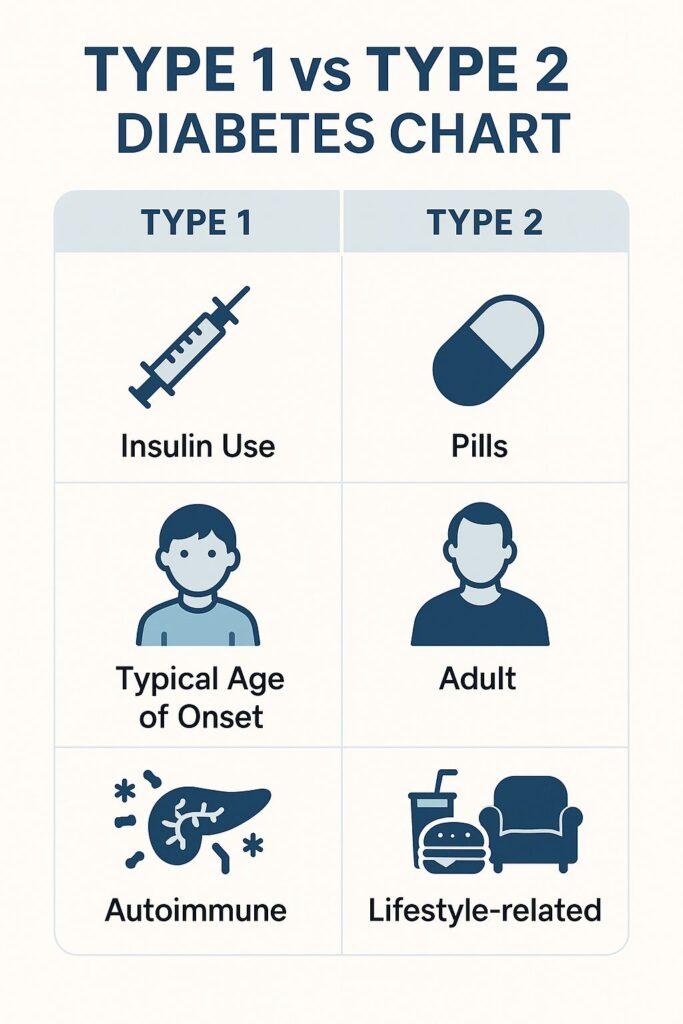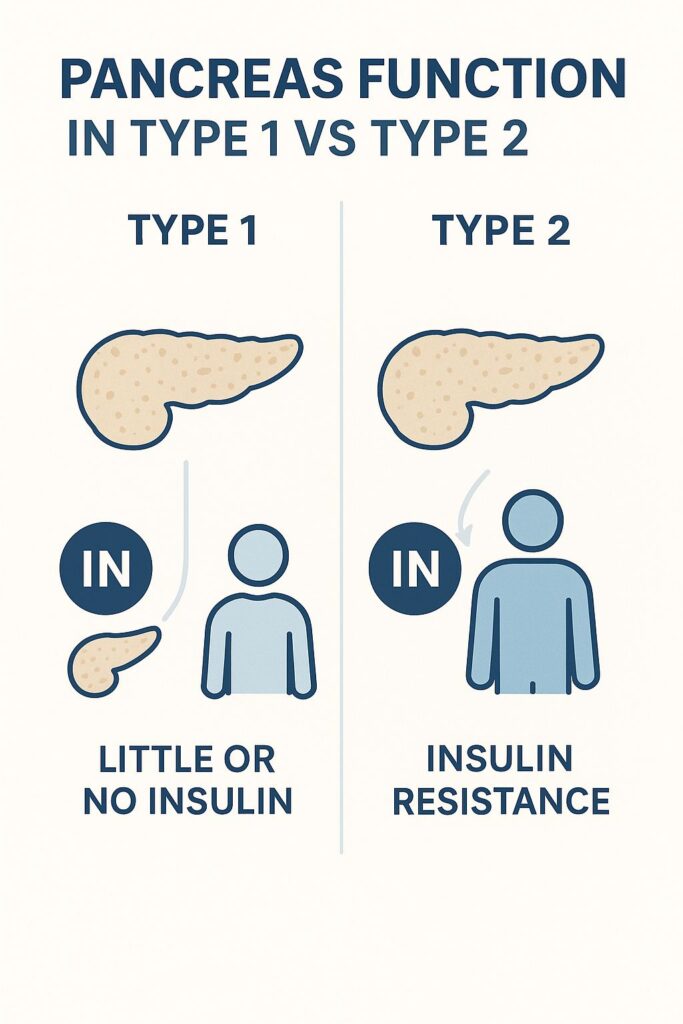As a licensed pharmacist, one of the most common questions I hear from patients is: “What’s the difference between type 1 and type 2 diabetes?” While both conditions are forms of diabetes mellitus and share similar symptoms, they are fundamentally different in their causes, onset, and management. Understanding these differences is not only essential for those living with diabetes but also for caregivers, family members, and anyone seeking to support a loved one.
This comprehensive guide explores type 1 vs type 2 diabetes, including symptoms, causes, treatment approaches, insulin dependency, and more—all backed by evidence and explained with compassion and clarity.
What is Diabetes?
Diabetes mellitus is a chronic condition that affects how your body uses glucose (sugar). Glucose is the primary source of energy for the body’s cells, but it needs the hormone insulin to enter those cells. In diabetes, this process is disrupted—either due to lack of insulin or resistance to its effects.
There are two primary types:
• Type 1 diabetes – autoimmune origin, insulin-dependent
• Type 2 diabetes – lifestyle-related and insulin resistance-driven
Overview: Type 1 vs Type 2 Diabetes

| Feature | Type 1 Diabetes | Type 2 Diabetes |
| Onset | Usually before age 30 | Usually after age 40 |
| Cause | Autoimmune destruction of insulin-producing cells | Insulin resistance, poor lifestyle |
| Insulin Dependency | Always requires insulin | May not require insulin initially |
| Reversibility | Not reversible | May be reversible in early sstages |
| Prevalance | 5-10% of diabetic cases | 90-95% of diabetes cases |
| Weight | Often lean | Often overweight or obese |
Causes of Type 1 and Type 2 Diabetes
Type 1 Diabetes Causes:
• Autoimmune reaction destroys pancreatic beta cells
• Genetic predisposition
• Environmental triggers (e.g., viruses)
• Not linked to lifestyle or diet
Type 2 Diabetes Causes:
• Insulin resistance in cells
• Pancreas fails to produce enough insulin over time
• Strong links to:
• Obesity
• Sedentary lifestyle
• Poor diet
• Family history
Source: American Diabetes Association
Type 1 Diabetes vs Type 2 Diabetes Symptoms
While many symptoms overlap, their progression and intensity vary.
Common Symptoms in Both:
• Frequent urination
• Increased thirst
• Fatigue
• Blurred vision
• Slow wound healing
Type 1-Specific Signs:
• Sudden weight loss
• Rapid onset
• Diabetic ketoacidosis (DKA) more common
Type 2-Specific Signs:
• Gradual onset
• Often unnoticed in early stages
• May include darkened skin patches (acanthosis nigricans)
Diagnosis: How Are They Identified?
Tests used for diagnosis include:
• Fasting Blood Glucose ≥126 mg/dL
• HbA1c ≥6.5%
• Random Glucose Test ≥200 mg/dL with symptoms
• Oral Glucose Tolerance Test (OGTT)
For Type 1, additional testing includes:
• C-peptide test (low in type 1)
• Autoantibody testing
Type 1 vs Type 2 Diabetes in Adults

Although type 1 is traditionally seen in children, it can occur in adults too—a condition called LADA (Latent Autoimmune Diabetes in Adults). It mimics type 2 initially but progresses to insulin dependence.
Key Point: If you’re an adult recently diagnosed with diabetes and insulin isn’t working, your doctor may consider antibody testing to rule out type 1.
Treatment Differences: Medications and Lifestyle
Type 1 Diabetes Treatment:
• Insulin is essential (basal-bolus regimens or insulin pumps)
• Continuous glucose monitoring (CGM)
• Carbohydrate counting
• No current cure
Type 2 Diabetes Treatment:
• Lifestyle changes (weight loss, diet, exercise)
• Oral medications like:
• Metformin
• SGLT2 inhibitors
• GLP-1 receptor agonists
• May progress to insulin if not controlled
Type 1 vs Type 2 Insulin Dependency
• Type 1: 100% insulin dependent for life
• Type 2: Initially managed without insulin; insulin added if oral meds fail
Diabetes Type 1 vs Type 2 Chart
| Criteria | Type 1 Diabetes | Type 2 Diabetes |
| Insulin Requirement | Always | Sometimes |
| Onset Age | Childhood/Teen | Adult(≥40) |
| Autoimmune Cause | Yes | No |
| Preventable | No | Largely Yes |
| Reversible | No | Sometimes |
| Common Meds | Insulin | Metformin, GLP-1, SGLT2 |
Frequently Asked Questions
Can type 2 diabetes turn into type 1?
No. Type 1 and type 2 have distinct causes. However, poorly managed type 2 diabetes can lead to insulin dependency, mimicking type 1.
Is type 1 diabetes more serious than type 2?
Both are serious. Type 1 has a more sudden onset and requires strict insulin management, while type 2 can lead to severe complications if untreated.
Can adults get type 1 diabetes?
Yes. Adults can develop LADA (Latent Autoimmune Diabetes in Adults), often misdiagnosed as type 2 initially.
Can type 2 diabetes be reversed?
Yes, early-stage type 2 can often be reversed through weight loss, diet, and exercise.
What is the life expectancy for someone with type 1 vs type 2?
With proper management, both can have near-normal life expectancy. Poor control increases risk of heart disease, kidney failure, and other complications.
Key Takeaways
• Type 1 is autoimmune, insulin-dependent, and typically affects younger individuals.
• Type 2 is lifestyle-related, more common, and often preventable or reversible in early stages.
• Symptoms may overlap, but diagnosis and treatment differ significantly.
• Understanding the difference between type 1 and type 2 diabetes is key to effective management.
• Always consult your healthcare provider for individualized treatment and care.
Medical Disclaimer
This article is for educational purposes only and does not constitute medical advice. Please consult your doctor, endocrinologist, or healthcare provider for personalized medical care.



Pingback: 10 Common Diabetes Myths Debunked by a Pharmacist - Pharma Heals
Pingback: Is Type 2 Diabetes Genetic? - Pharma Heals
Pingback: Understanding Diabetes Mellitus (Type 1, Type 2) & Diabetic Ketoacidosis (DKA) - Pharma Heals
Pingback: Diabetes Test Kit Guide for Accurate Home Monitoring - Pharma Heals